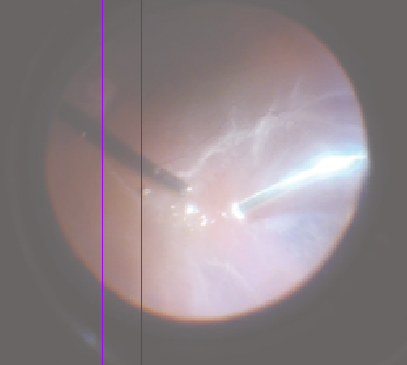Vitrectomy: Is higher speed always better?
Physicians should consider hydrodynamic cavitation when performing this procedure.
Figure 1 Intraoperative image showing bubbles caused by the cavitation phenomenon during vitrectomy. (Image courtesy of Jorge Monasterio Bel, MD)

The aim of vitrectomy surgery is to achieve the most complete removal of vitreous while minimizing complications and maximizing surgical outcomes. Recent technologic advances have allowed the introduction of increasingly smaller calibers (microincision vitrectomy surgery) and vitreous cutting speeds up to 10,000 cuts per minute (cpm) in each port, enhancing the safety and effectiveness of vitreous base surgery.1
The dynamics of the vitreous flow rate through the vitrectomy probe are determined by a combination of factors including cut rate, vacuum, duty cycle, and inner diameter of the vitrector. Increasing the number of cpm results in a smaller quantity of vitreous entering the port of the handpiece with each cut, thereby transmitting less traction to the retina and reducing the risk of iatrogenic tearing or movement of a detached retina.2
Surgical phenomenon
During posterior vitrectomy using the Constellation Vision System with the high-speed vitrectomy probe (Ultravit, Alcon) capable of operating at 7500 cpm with 1 port, small bubbles appeared around the vitreous handpiece port with the maximum cut rate in shave mode (Figure 1). These bubbles were not air, did not migrate behind the posterior capsule, and disappeared just after decreasing the cut rate below 5500 cpm.
This phenomenon is called cavitation. Cavitation is a phenomenon in which the pressure level of a liquid drops below the liquid’s vapor pressure level, leading to the formation of small vapor-filled cavities in the liquid. Hermann von Helmholtz, who revolutionized the field of ophthalmology in the 19thcentury with the invention of the ophthalmoscope and theory of accommodation, also studied vortex dynamics in inviscid fluids. Until the publication of Helmholtz’s paper,3 the integrals of the hydrodynamic equations had been determined almost exclusively on the presumption that the Cartesian components of the velocity of each fluid particle were partial first derivatives of the velocity potential. Helmholtz eliminated this limitation and considered the effects of friction between different elements of the fluid or between the fluid and a solid boundary.
Hydrodynamic cavitation4 can be produced by passing a liquid through a constricted channel at a specific flow velocity. A local increase in flow velocity could lead to a pressure level drop to the critical point at which cavitation could be initiated (based on the Bernoulli principle).
The critical pressure point is vapor-saturated pressure. In a closed fluidic system where no flow leakage is detected, a decrease in cross-sectional area would lead to velocity increment and hence a pressure level drop. The combination of pressure and kinetic energy can create the hydrodynamic cavitation cavern downstream of the local constriction, generating high-energy cavitation bubbles.
This physical phenomenon has its applications. Hydrodynamic cavitation can improve some industrial processes. Cavitation is often used to homogenize (ie, mix and break down) suspended particles in a colloidal liquid compound. In industrial cleaning applications, cavitation has sufficient power to overcome the particle-to-substrate adhesion forces, loosening contaminants.5 And in medical use, it has an important role in the destruction of kidney stones in shock wave lithotripsy.
Unfortunately, cavitation can also be an undesirable occurrence. In devices such as propellers and pumps, cavitation causes a great deal of noise, damage to components, vibrations, and loss of efficiency.
Current vitreous cutters can deliver cut rates up to 16,000 cpm depending on the vitrectomy platform (eg, enhancing visual acuity), and they have been designed to improve the cutting of the vitreous in both directions of the blade (2-dimensional cutting) to duplicate the cut speed effectively. Meanwhile, the port is open during 92% of the duty cycle, which minimizes the cavitation effect.6
Conclusions
If cavitation bubbles might result in harm by obscuring the surgeon’s view or via another mechanism, then limiting these bubbles may be advantageous. Increasing high-speed cut rate to 20,000 cpm or more is effective when associated with a dual-blade, dual-port vitrectomy to reduce surge turbulence at aspiration and hydrodynamic cavitation at the tip of the vitrectomy probe.•
References
1 Abulon D. Vitreous flow rates of 27 gauge dual-cutting 20,000 cpm vitrectomy probes. Presented at: 22nd EVER Congress; October 17-19, 2019; Nice, France.
2 Rizzo S, Genovesi-Ebert F, Belting C. Comparative study between a standard 25-gauge vitrectomy system and a new ultrahigh-speed 25-gauge system with duty cycle control in the treatment of various vitreoretinal diseases. Retina. 2011;31(10):2007-2013. doi:10.1097/IAE.0b013e318213623a
3 von Helmholtz H. On discontinuous motions of fluids. Papers of the Royal Prussian Academy of Sciences in Berlin. 1868;23:215-228.
4 Moholkar VS, Pandit AB. Bubble behavior in hydrodynamic cavitation: effect of turbulence. AIChE J. 1997;43(6):1641-1648. doi:10.1002/aic.690430628
5 Gogate PR, Kabadi AM. A review of applications of cavitation in biochemical engineering/biotechnology. Biochem Eng J. 2009;44(1):60-72. doi:10.1016/j.bej.2008.10.006
6 Ribeiro L, Oliveira J, Kuroiwa D, et al. Advances in vitreoretinal surgery. J Clin Med. 2022;11(21):6428. doi:10.3390/jcm11216428

Newsletter
Keep your retina practice on the forefront—subscribe for expert analysis and emerging trends in retinal disease management.